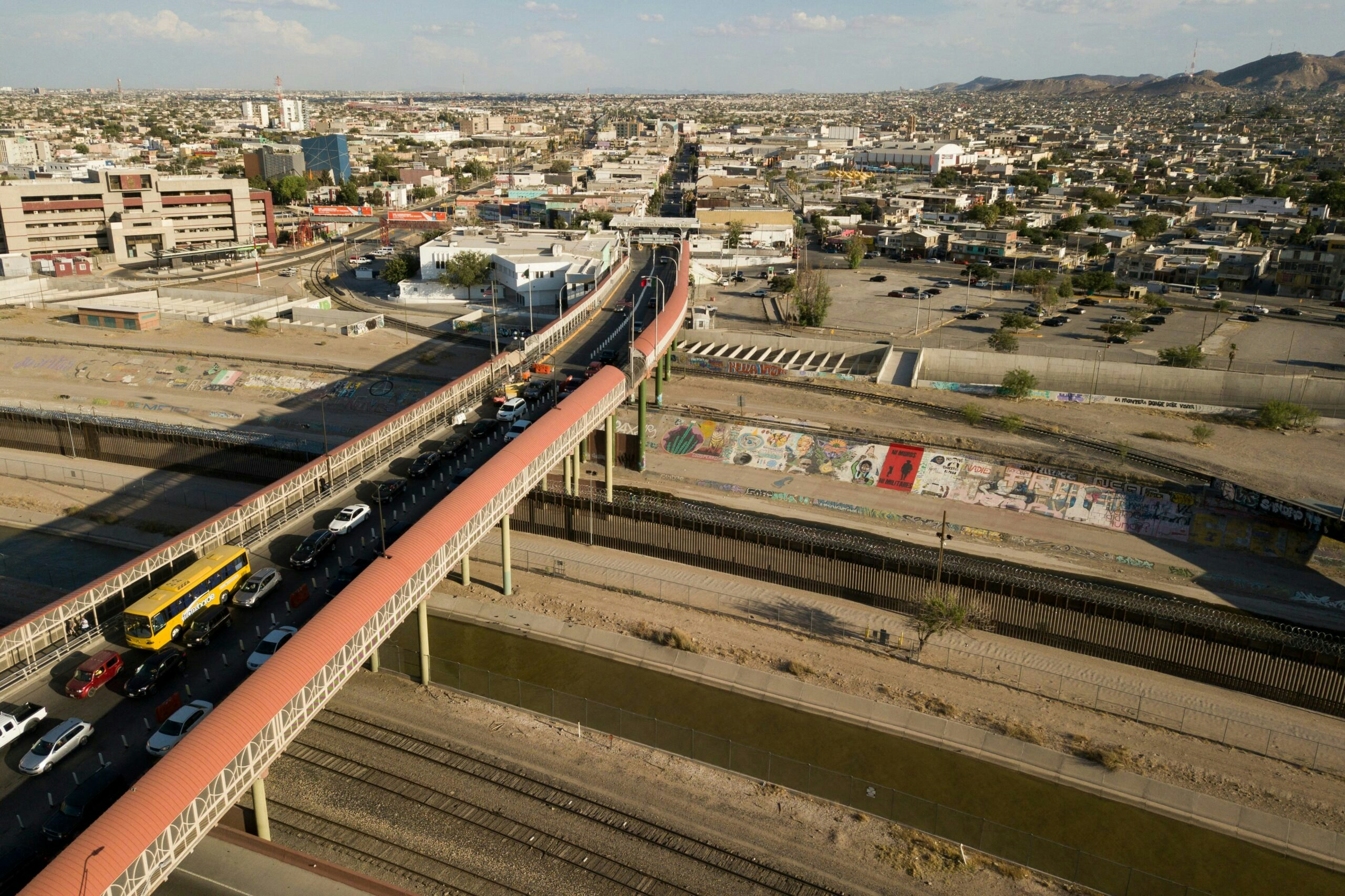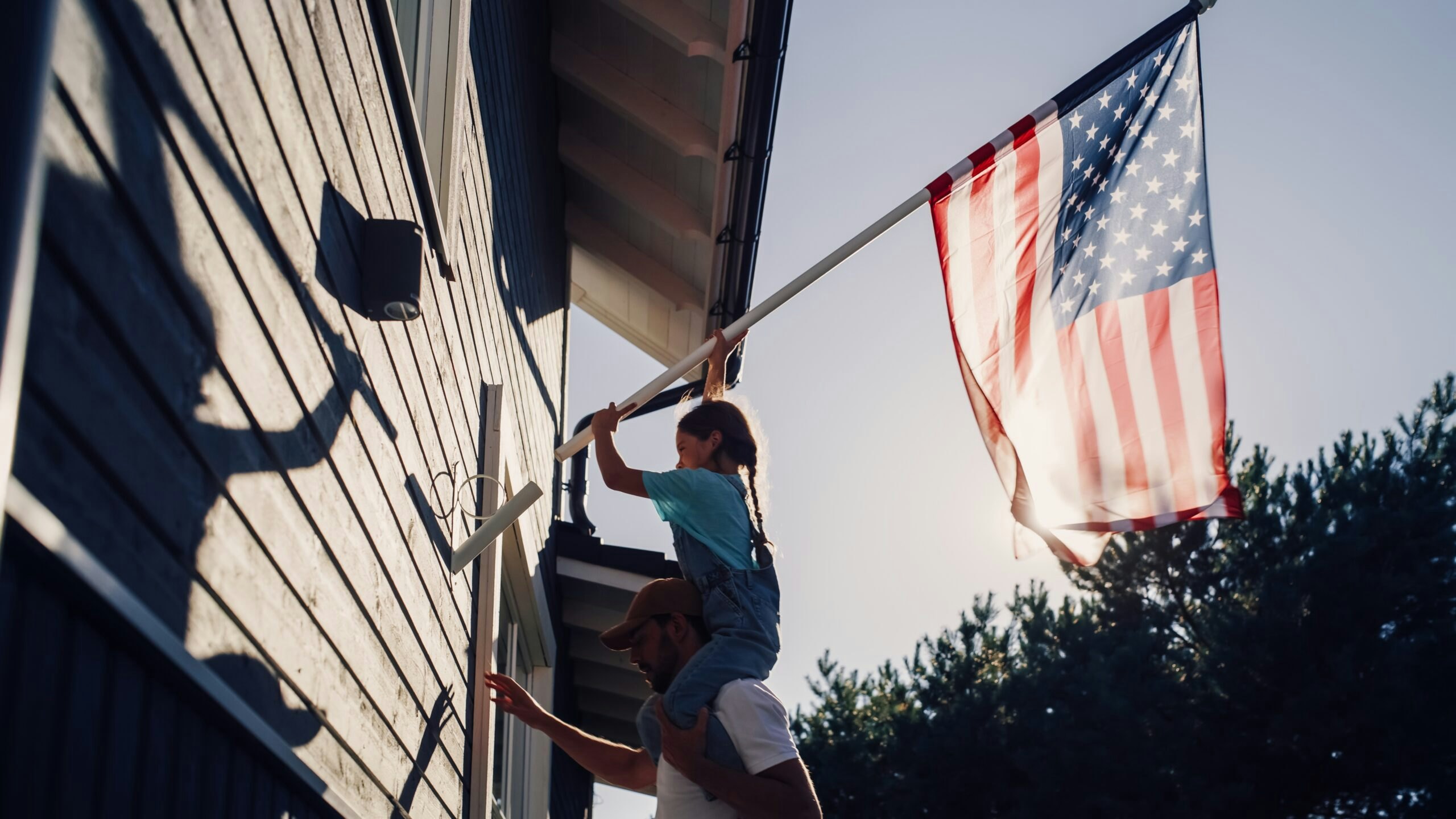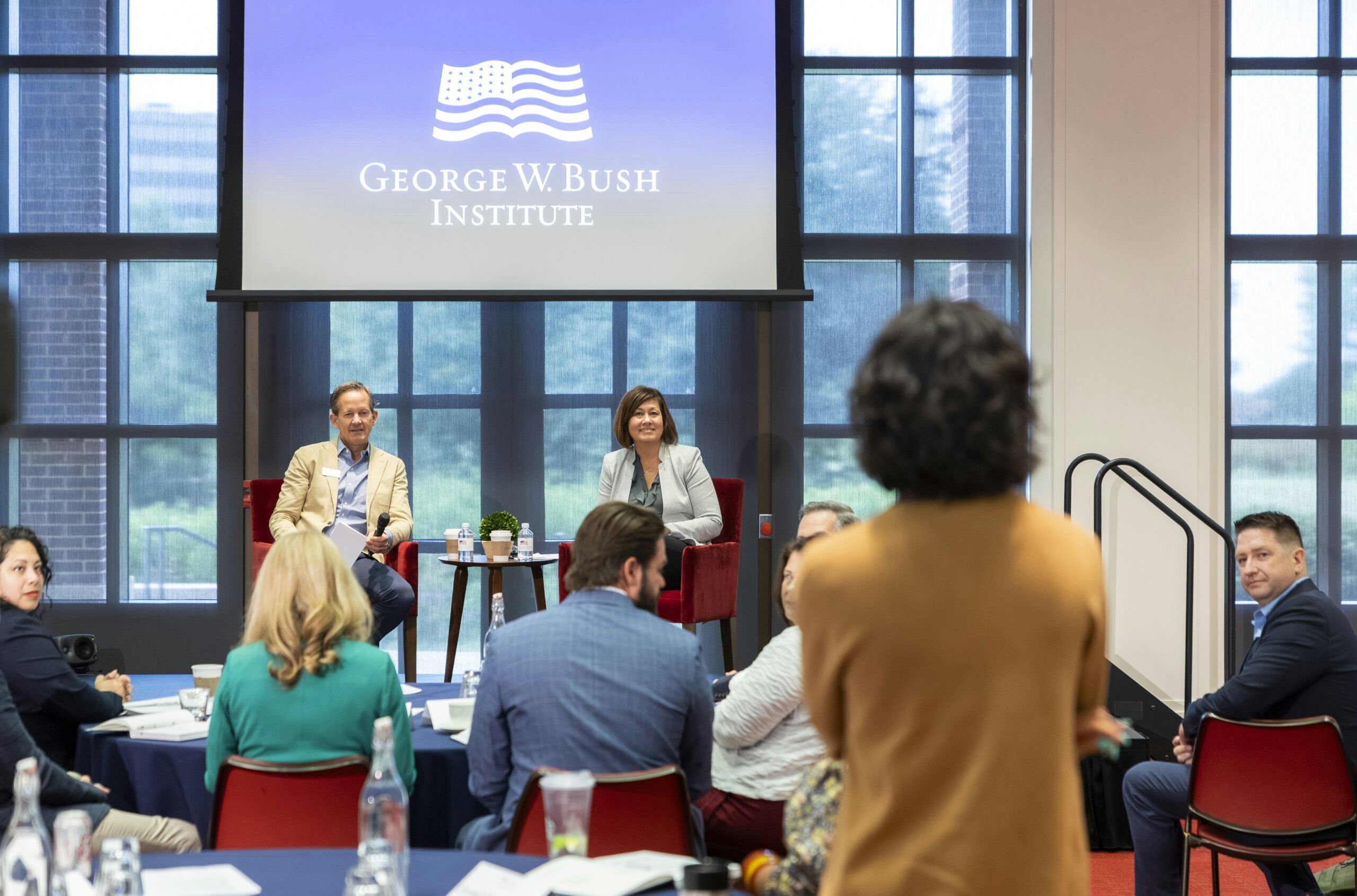Throughout 2025, the George W. Bush Institute will continue exploring the nature of pluralism and how it’s working in our country. Improving our commitment to pluralism is intrinsically tied to strengthening our democracy.
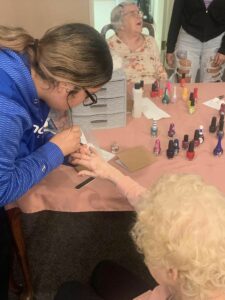
On any given Wednesday, all the high school students from the 370-person junior and senior high school in Union City, Indiana, break into teams to address one aspect of their hometown’s needs. One group of students heads out to work on improving their city’s park and playground. Another serves in an animal shelter. A third visits elderly residents in a nursing home.
The students may operate in teams, but those we spoke with last fall consider Workforce Wednesday one big project. “Wednesday was my favorite day,” one student told us via Zoom. “Workforce Wednesday gets us out into the community,” said another. “Teamwork is what we do best.” As one teacher said, “We show up for each other.”
Shared projects create community
The Union City example is not the only incident of community projects binding people together.
Over the last few months of interviewing rural students, we have repeatedly heard how service projects strengthen the social tolerance of their communities. A healthy dose of social tolerance allows people to work together despite their differences.
“Workforce Wednesday lifts each other up and lets students get dirty while they do it,” one teacher said of the projects.
Far away in Milano, Texas, which is 70 miles northeast of Austin, we found high school students similarly working together. Every Friday, members of Family Career and Community Leaders of America provide food to kids in need. Others host coat drives for people in need. Some helped families devastated by a shooting in nearby Rockdale. One student dressed up in a festive costume to entertain the kids along the sheriff’s big Christmas parade route.
Not long into our meeting with Milano students in the school’s band hall, heads started nodding as peers described community projects. Soon, they all began talking about their work for the community. “I like to help people,” one student related. “Picking up trash on the road makes you feel you can do more.”
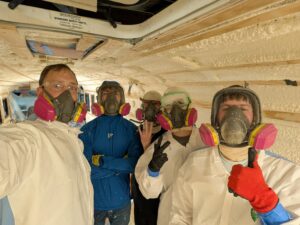 Several cited how the community itself pushes students to do more. “The community helps us help others,” is how one described the relationship with the town as a whole. “They get us to try harder.”
Several cited how the community itself pushes students to do more. “The community helps us help others,” is how one described the relationship with the town as a whole. “They get us to try harder.”
Students in each rural school we visited emphasized how everyone needs to pitch in at school or things don’t get done. Unlike on a big urban campus or suburban high school with larger populations, there are no football, volleyball, or basketball teams in a rural school if the majority of students don’t participate. Nor is there a theater club or marching band or cheer squad or any other endeavor that most of us associate with extracurricular high school life.
Community is created in schools like these by everyone pitching in. That often means joining one or more teams, groups, or clubs.
Not that everything is done perfectly. It isn’t. Nor must students have all the right skills. “You don’t have to be excellent to participate,” we were told. But activities don’t occur, and needs don’t get met, unless people step forward in rural schools.
The lesson for those of us who didn’t grow up or live in a rural town is to find projects in our community that bring together volunteers from different backgrounds. Think of it as a social investment that pays dividends in the form of building trust, developing friendships, and providing purpose. Not only does such work address a community’s need, but it creates bonds with others who may see the world differently. We then can start having the kinds of conversations that help us better understand each other. Importantly, we start seeing each other as friends or neighbors, not as “the other.”
Taking advantage of a small size and common (rural) identity
A second significant lesson from rural schools is that breaking groups down into manageable sizes makes it easier to “practice pluralism.” It’s much easier, after all, to get to know and understand others in a workplace of only a few dozen people, an intimate house of worship, a small school, or a neighborhood association than in, say, a massive lecture hall, a large corporate setting, or even on the wide-open internet.
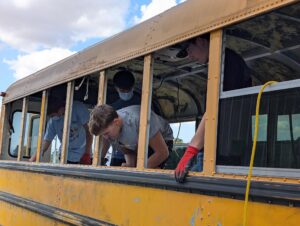
The sheer proximity of people to each other breaks down barriers. We heard that often from students, teachers, and administrators in places like Marfa, Texas, which sits about 60 miles from the U.S./Mexico border. “We are so small,” one Marfa administrator told us about her district’s 58-person high school, “students have to see everyone. You can’t ignore your ex-boyfriend walking down the hall.”
True, such settings can breed drama, as one teacher told us. That’s an unavoidable part of human nature. But pathos can’t last too long in a small setting. “Everybody knows everybody, so you have to come to terms,” the administrator explained.
This gets back to the reality of rural schools: Everyone must participate, or a sport doesn’t get played, a concert doesn’t get conducted, a school play goes unperformed, a community project doesn’t get done. You could call it multi-tasking on steroids, but the need for all to lock arms breeds relationships. “We depend upon one another,” said a teacher. “This is all we have.” Or, as one educator in Union City put it: “I have never met a president, but I know my neighbor’s needs.”
What we heard from students as well as administrators is that the small size of their schools and communities creates a sense of belonging. “The small community culture takes on a bigger purpose,” one administrator told us in Thrall, Texas, which sits northeast of Austin. “Every member counts.”
The communities, though, must work to create a sense of belonging for those who feel on the outside. Thrall ISD, which serves about 800 students, holds a “New Tiger” night for students and parents entering the district. They learn about the history of the town and about traditions such as the community’s harvest festival. The district also offers “Thrall dogs” on those “New Tiger” nights as a way to celebrate the town and create a common identity. This ritual takes a regular hot dog and makes it a shared community tradition that creates a sense of belonging.
Marfa ISD, which consists of two schools that together serve students from elementary through 12th grade, is somewhat unique in that the longstanding ranching and farming community became an arts destination when the late artist Donald Judd set up shop in the far-flung West Texas town in the 1970s. His high-concept, minimalist art became a destination point for artists and their patrons. Today, Marfa combines a creative class of artists and writers with residents who, in some cases, have worked the land for generations. Or who come from Mexico to work each day.
This duality has created what some students described as two Marfas. Tourists and newcomers may stroll through the galleries, but students do not necessarily visit them. As a result, the small community has had to be intentional in building bridges.
One bridge-builder is the annual Marfa Lights Festival. The Labor Day pageant is a shared project that brings visitors and residents together. Marfa’s high school volleyball games are another way to bring residents together. “Families rally around the team,” one person told us. And students cited how churches and youth religious organizations like Young Life get people working side-by-side.
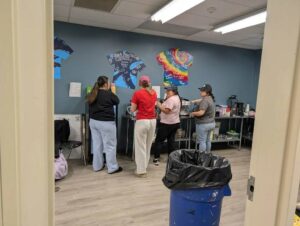 We also found that interests in agriculture and rural life bonded some students together. They talked about raising livestock, fishing, and hunting as bringing students together. One described a rural ethic of commitment to work.
We also found that interests in agriculture and rural life bonded some students together. They talked about raising livestock, fishing, and hunting as bringing students together. One described a rural ethic of commitment to work.
A common identity can be a two-edged sword. Too much homogeneity can create a chilling effect where some issues don’t come to the surface or people don’t express true feelings. We certainly heard that. But a shared identity can benefit a group in other ways, such as through providing a common set of values. Debate about different topics can more easily take place within that context. Knowing that you share common values helps people disagree about some topics in a more respectful way. After all, you may know your neighbor in a way you don’t know someone living far away.
The lesson here is to start small in building relationships, use shared beliefs to engage in difficult conversations, and welcome the outsider.
Schools as a community hub
About 760 of Texas’ 1,200 school districts have less than 1,500 students, according to the Texas Association of Rural Schools. Not every one of those districts qualifies as rural in the traditional meaning of small towns and open lands. But many do and each district is woven into the fabric of the community. “The school is the community,” says Randy Willis, executive director of the Texas Association of Rural Schools. They often are the biggest institution in town.
We found schools to be the hub of the communities we studied. For one thing, campuses are the source of entertainment. Sporting events. Music and theater performances. Festivals like the Marfa Lights. “School activities drive the culture,” explains Willis, who previously led Granger ISD in Central Texas.
Schools also are where the larger community gathers for other reasons. Thrall ISD recently hosted a memorial service on its football field for a former student who later attended the Air Force Academy. “Make schools a second home,” a Thrall teacher said about the importance of schools bringing together people of different backgrounds.
The teacher/student relationship plays a role as well in schools serving as a community hub. In our interviews, teachers described knowing kids personally. This helps them hold those students accountable if they start causing trouble. “We only have one hallway,” a Milano teacher smiled as she made the point about knowing what might be going on with students.
Knowing kids personally makes it easier for teachers to forge common ground among students. “It’s the skill of the teacher to bridge differences,” Willis told us. “Managing nuances is the art of teaching.”
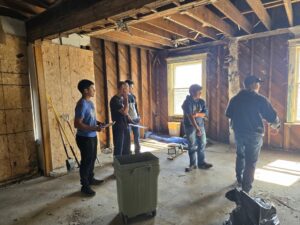 Ironically, avoiding insularity may be easier in small settings. Principals and teachers, even superintendents, know where students live. They may know a youth’s parents. Or see the student in stores. Maybe even teach them in Sunday school.
Ironically, avoiding insularity may be easier in small settings. Principals and teachers, even superintendents, know where students live. They may know a youth’s parents. Or see the student in stores. Maybe even teach them in Sunday school.
This interaction creates a relationship that transcends the classroom. When the relationships work well, teachers can help all students feel a sense of belonging. That includes in the larger community. “The staff is devoted to helping young people develop civic responsibility,” a veteran Milano ISD teacher told us. “We jump on kids if they go after another person.”
Schools serving as a community hub and the teacher/student relationship are two ways rural schools create social glue. That level of accountability, along with the visibility they provide, can help develop the character of students and inspire them to be better citizens for the community. But this kind of setting doesn’t have to be limited to small, rural districts. One educator told us some mega-Texas high schools are trying to replicate the same environment.
Let us hope they do. Schools and the educators who work in them can make it possible to create a sense of one amidst differences.
Yes, differences exist
We’re not trying to create some idyllic, romanticized picture of rural schools. Differences exist, just like they do elsewhere. “Who doesn’t have conflict?” a Thrall ISD teacher asked rhetorically.
One teacher said it was hard to find common ground among adults in his community. And, among kids, their adolescent anger can make finding common ground difficult. “Kids can be brutal,” an educator said.
Students in Milano talked about not liking someone pushing an agenda on them. They get frustrated when that happens.
We also heard from teachers across the districts how social media makes it harder to break down siloes or get students’ attention. “Social media is about promoting yourself,” one Milano teacher lamented.
Here’s another challenge: In a place like Marfa, where separate cultures exist, students and adults can feel like they live in between cultures. In small towns with a homogenous population, people may keep things inside themselves out of fear of upsetting the peace. “It’s harder to stick out,” said one student of her district.
Still, despite the differences they encounter, rural schools can and do “practice pluralism.” An Indiana teacher told us that people find a middle ground when they approach an issue with an open mind. “Voice your opinion, but don’t attack each other,” one Union City student emphasized in capturing the essence of pluralism.
In Milano, a similar sentiment was expressed. All heads nodded when we asked if differences exist. Yet students talked about how conversations help them understand how others think. “We had a respectful debate about abortion,” another reported. One concluded that he would rather win a baseball game than an argument.
In essence, relationships matter.
The promise and peril of homogeneity
“Practicing pluralism” is not easy and it particularly can be challenging amidst homogeneity. Common values are somewhat like being together in a church, where parishioners sing from the same hymnbook. Yet tensions arise when others within a community think differently. A commitment to pluralism requires working through these realities, avoiding groupthink while holding onto common values.
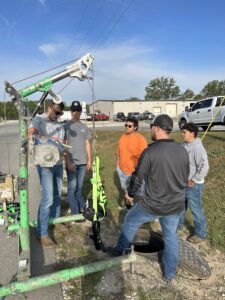 Simmering beneath the surface of homogenous communities is a tension between beliefs and institutions that form character versus forces that push people into going along to get along. Navigating through these points of tension is why we need a pluralistic society, and that is no different for rural schools. As Randy Willis says, each district is a microcosm that requires managing conflict.
Simmering beneath the surface of homogenous communities is a tension between beliefs and institutions that form character versus forces that push people into going along to get along. Navigating through these points of tension is why we need a pluralistic society, and that is no different for rural schools. As Randy Willis says, each district is a microcosm that requires managing conflict.
We learned that certain levels of homogeneity are positive. It allows for a common purpose or mission to develop that catalyzes the practice of pluralism. That could be in the form of values like those laid out in America’s founding documents, a unifying project, or even adversity.
We’ve seen this idea repeatedly across a number of areas writing for the Pluralism Challenge. For example, in our essay, “Making space for different faiths is important in a strong democracy,” we described how the Dallas-Fort Worth Muslim-Jewish Advisory Council finds shared struggle in fighting against bigotry committed against their respective faiths.
Throughout this piece, we’ve recounted various festivals, sporting events, community service organizations, local rituals, and simply the daily interactions and routines of attending school in rural towns. These social touchpoints welcome people into the community as well as contribute to a sense of belonging. That in turn fosters the relationships and community trust that creates a small town “e pluribus unum” effect.
However, too much homogeneity can suffocate the practice of pluralism because there can be pressure to “go along, to get along.” Why rock the boat by offering a different point of view or argument if it only disrupts social harmony? If that mindset solidifies broadly within the community, there’s a danger that the social guardrails produced by proximity, accountability, and visibility in these rural communities could morph from curbing bad behavior to coercive peer pressure. This could stifle the free flow of ideas, disagreement, or even the ability to hold different identities simultaneously.
In one of the towns, we heard how these negative aspects were perhaps manifested in an unexpected way. Teachers shared with us that some students in a friend group made insensitive remarks about a particular ethnic group. This happened in front of friends who were of that ethnicity. When confronted by teachers who overheard the inappropriate comments, the offending students seemed genuinely confused. They suggested that they weren’t referring to their friends because they were “one of us.”
And despite the teachers’ skepticism, those involved denied being offended or targeted by the remarks. Was that really the case or were they going along to get along? We don’t definitively know, but you can imagine how one might be hesitant to disrupt social peace or call out a friend for fear of being labeled a malcontent.
The big takeaway is that practicing pluralism in such communities (or elsewhere) requires balancing homogeneity with the ability to express opposing views or maintain different identities while remaining connected with the community. Admittedly, that line may not be always clear or universally applicable. In true pluralistic fashion, communities themselves are responsible for defining what norms are acceptable and how to enforce them.
Practically, though, it’s helpful to have local processes, forums, or institutions – like town hall meetings, school boards, local newspapers, classroom debates, and clubs – where people feel comfortable arguing ideas or maintaining different identities. At the very least, these things can be a bulwark against group think.
Conflict can be managed when people in a community are intentional about putting these points into practice. Once they do, they can start having those difficult conversations that explore the differences people have about politics, culture, religion, or any other potential points of division.
Conclusion
As we think about how pluralism is practiced in different communities, we’re reminded that the commitment to doing so isn’t easy. Pluralism simultaneously requires us to come together on shared endeavors while allowing individuals or smaller groups to invest in their own interests – even if that’s at odds with the majority.
Doing so can certainly go against human nature that tends to prioritize self-love over the community or the interests of our own tribe. Perhaps though, we can draw inspiration from these rural communities that seem to be fine-tuning that balance between community and individuality. This is encouraging at a time when many Americans seem bitterly divided over national politics or culture war issues. Those of us in larger urban areas across the United States might find ways to replicate the positive rural town practices and institutions that are fostering a greater sense of belonging, citizenship, and purpose.



























